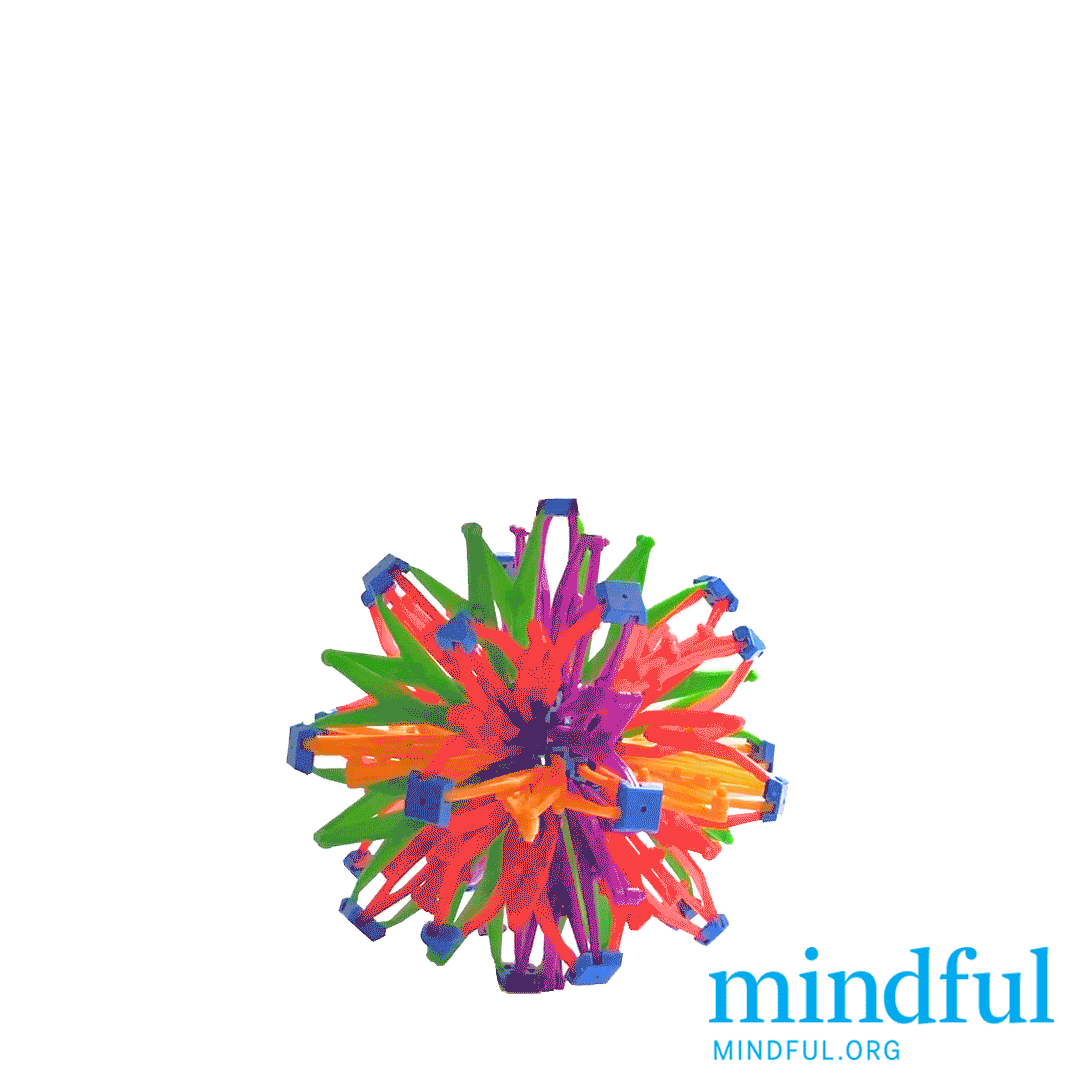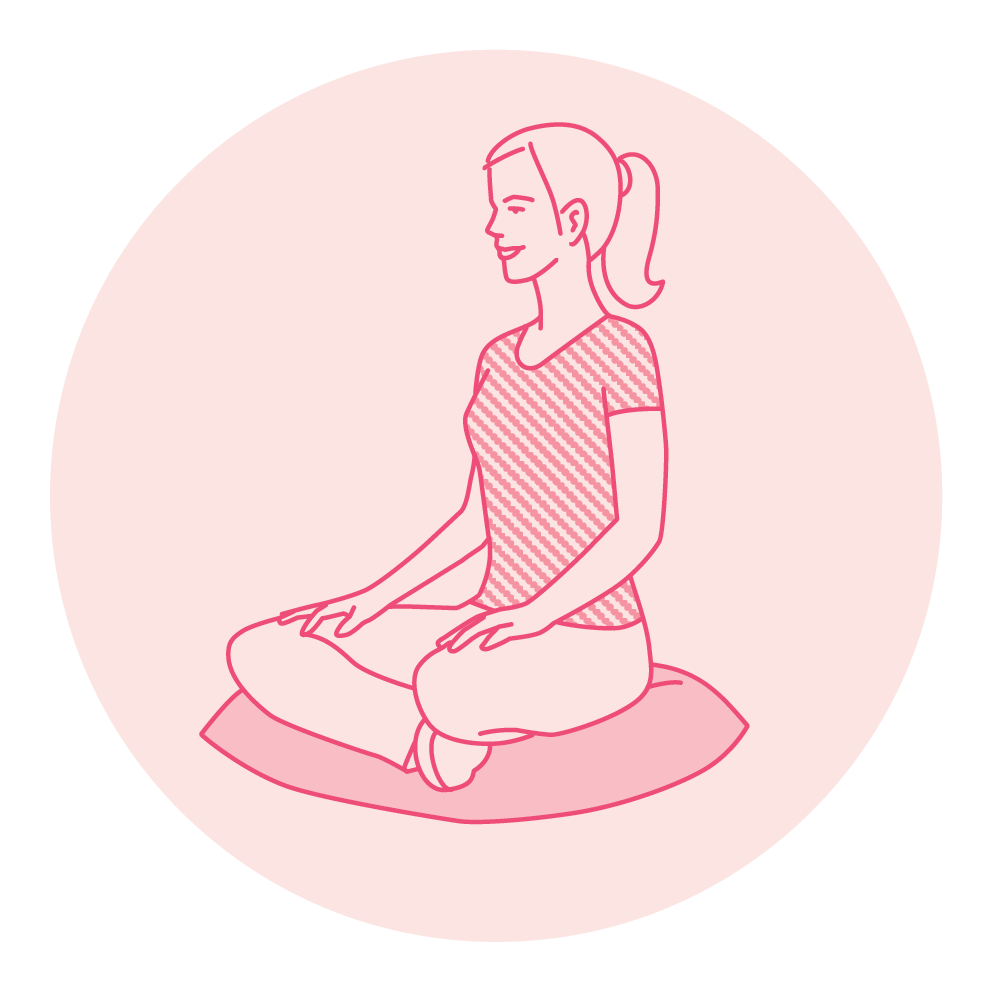When we meditate, we inject far-reaching and long-lasting benefits into our lives: We lower our stress levels…
we get to know our pain, we connect better, we improve our focus, and we’re kinder to ourselves. Let us walk you through the basics in our new mindful guide on how to meditate.
How do you learn to meditate? In mindfulness meditation, we’re learning how to pay attention to the breath as it goes in and out, and notice when the mind wanders from this task. This practice of returning to the breath builds the muscles of attention and mindfulness.
When we pay attention to our breath, we are learning how to return to, and remain in, the present moment—to anchor ourselves in the here and now on purpose, without judgement.
In mindfulness practice, we are learning how to return to, and remain in, the present moment—to anchor ourselves in the here and now on purpose, without judgement.
The idea behind mindfulness seems simple—the practice takes patience. Indeed, renowned meditation teacher Sharon Salzberg recounts that her first experience with meditation showed her how quickly the mind gets caught up in other tasks. “I thought, okay, what will it be, like, 800 breaths before my mind starts to wander? And to my absolute amazement, it was one breath, and I’d be gone,” says Salzberg.
While meditation isn’t a cure-all, it can certainly provide some much-needed space in your life. Sometimes, that’s all we need to make better choices for ourselves, our families, and our communities. And the most important tools you can bring with you to your meditation practice are a little patience, some kindness for yourself, and a comfortable place to sit.
A Basic Meditation for Beginners
The first thing to clarify: What we’re doing here is aiming for mindfulness, not some process that magically wipes your mind clear of the countless and endless thoughts that erupt and ping constantly in our brains. We’re just practicing bringing our attention to our breath, and then back to the breath when we notice our attention has wandered.
- Get comfortable and prepare to sit still for a few minutes. After you stop reading this, you’re going to simply focus on your own natural inhaling and exhaling of breath.
- Focus on your breath. Where do you feel your breath most? In your belly? In your nose? Try to keep your attention on your inhale and exhale.
- Follow your breath for two minutes. You can use the breath ball—inhaling as the ball expands, exhaling when the ball contracts.

Welcome back. What happened? How long was it before your mind wandered away from your breath? Did notice how busy your mind was even without your consciously directing it to think about anything in particular? Did you notice yourself getting caught up in thoughts before you came back to reading this? We often have little narratives running in our minds that we didn’t choose to put there, like: “Why DOES my boss want to meet with me tomorrow?” “I should have gone to the gym yesterday.” “I’ve got to pay some bills” or (the classic) “I don’t have time to sit still, I’ve got stuff to do.”
We “practice” mindfulness so we can learn how to recognize when our minds are doing their normal everyday acrobatics, and maybe take a pause from that for just a little while so we can choose what we’d like to focus on.
If you experienced these sorts of distractions (and we all do), you’ve made an important discovery: simply put, that’s the opposite of mindfulness. It’s when we live in our heads, on automatic pilot, letting our thoughts go here and there, exploring, say, the future or the past, and essentially, not being present in the moment. But that’s where most of us live most of the time—and pretty uncomfortably, if we’re being honest, right? But it doesn’t have to be that way.
We “practice” mindfulness so we can learn how to recognize when our minds are doing their normal everyday acrobatics, and maybe take a pause from that for just a little while so we can choose what we’d like to focus on. In a nutshell, meditation helps us have a much healthier relationship with ourselves (and, by extension, with others).
LEARN TO MEDITATE
When we meditate, we inject far-reaching and long-lasting benefits into our lives. And bonus: you don’t need any extra gear or an expensive membership.
Here are five reasons to meditate:
1: Understand your pain
2: Lower stress
3: Connect better
4: Improve focus
5: Reduce brain chatter
How to Meditate
Meditation is simpler (and harder) than most people think. Read these steps, make sure you’re somewhere where you can relax into this process, set a timer, and give it a shot:
- Take a seat. Find a place to sit that feels calm and quiet to you.
- Set a time limit. If you’re just beginning, it can help to choose a short time, such as five or 10 minutes.
- Notice your body. You can sit in a chair with your feet on the floor, you can sit loosely cross-legged, you can kneel—all are fine. Just make sure you are stable and in a position you can stay in for a while.
- Feel your breath. Follow the sensation of your breath as it goes in and as it goes out.
- Notice when your mind has wandered. Inevitably, your attention will leave the breath and wander to other places. When you get around to noticing that your mind has wandered—in a few seconds, a minute, five minutes—simply return your attention to the breath.
- Be kind to your wandering mind. Don’t judge yourself or obsess over the content of the thoughts you find yourself lost in. Just come back.
- That’s it! That’s the practice. You go away, you come back, and you try to do it as kindly as possible.
- Close with kindness. When you’re ready, gently lift your gaze (if your eyes are closed, open them). Take a moment and notice any sounds in the environment. Notice how your body feels right now. Notice your thoughts and emotions.
Meditation 101: The Basics
A 3-part guided audio series from Barry Boyce
How long would you like to meditate? Sometimes we only have time for a quick check-in, sometimes we can dip in a little longer. Meditating every helps build awareness, fosters resilience, and lower stress. Try to make meditation a habit by practicing with these short meditations from our Editor-in-Chief Barry Boyce. Find time to site once a day for one month and see what you notice.
More Meditation Techniques:
We’ve gone over the basic breath meditation so far, but there are other mindfulness techniques that use different focal points than the breath to anchor our attention—external objects like a sound in the room, or something broader, such as noticing spontaneous things that come into your awareness during an aimless wandering practice. But all of these practice have one thing in common: We notice that our minds ARE running the show a lot of the time. It’s true. We think thoughts, typically, and then we act. But here are some helpful strategies to change that up:
How to Make Mindfulness a Habit
It’s estimated that 95%of our behavior runs on autopilot. That’s because neural networks underlie all of our habits, reducing our millions of sensory inputs per second into manageable shortcuts so we can function in this crazy world. These default brain signals are so efficient that they often cause us to relapse into old behaviors before we remember what we meant to do instead.
Mindfulness is the exact opposite of these default processes. It’s executive control rather than autopilot, and enables intentional actions, willpower, and decisions. But that takes practice. The more we activate the intentional brain, the stronger it gets. Every time we do something deliberate and new, we stimulate neuroplasticity, activating our grey matter, which is full of newly sprouted neurons that have not yet been groomed for “autopilot” brain.
But here’s the problem. While our intentional brain knows what is best for us, our autopilot brain causes us to shortcut our way through life. So how can we trigger ourselves to be mindful when we need it most? This is where the notion of “behavior design” comes in. It’s a way to put your intentional brain in the driver’s seat. There are two ways to do that—first, slowing down the autopilot brain by putting obstacles in its way, and second, removing obstacles in the path of the intentional brain, so it can gain control.
Shifting the balance to give your intentional brain more power takes some work, though. Here are some ways to get started.
- Put meditation reminders around you. If you intend to do some yoga or to meditate, put your yoga mat or your meditation cushion in the middle of your floor so you can’t miss it as you walk by.
- Refresh your reminders regularly. Say you decide to use sticky notes to remind yourself of a new intention. That might work for about a week, but then your autopilot brain and old habits take over again. Try writing new notes to yourself; add variety or make them funny. That way they’ll stick with you longer.
- Create new patterns. You could try a series of “If this, then that” messages to create easy reminders to shift into intentional brain. For instance, you might come up with, “If office door, then deep breath,” as a way to shift into mindfulness as you are about to start your workday. Or, “If phone rings, take a breath before answering.” Each intentional action to shift into mindfulness will strengthen your intentional brain.
More Mindfulness Meditations
Once you have explored a basic seated meditation practice, you might want to consider other forms of meditation including walking and lying down. Whereas the previous meditations used the breath as a focal point for practice, these meditations below focus on different parts of the body.
Body Scan Meditation

Try this: feel your feet on the ground right now. In your shoes or without, it doesn’t matter. Then track or scan over your whole body, bit by bit—slowly—all the way up to the crown of your head. The point of this practice is to check in with your whole body: Fingertips to shoulders, butt to big toe. Only rules are: No judging, no wondering, no worrying (all activities your mind may want to do); just check in with the physical feeling of being in your body. Aches and pains are fine. You don’t have to do anything about anything here. You’re just noticing.
Begin to focus your attention on different parts of your body. You can spotlight one particular area or go through a sequence like this: toes, feet (sole, heel, top of foot), through the legs, pelvis, abdomen, lower back, upper back, chest shoulders, arms down to the fingers, shoulders, neck, different parts of the face, and head. For each part of the body, linger for a few moments and notice the different sensations as you focus.
The moment you notice that your mind has wandered, return your attention to the part of the body you last remember.
If you fall asleep during this body-scan practice, that’s okay. When you realize you’ve been nodding off, take a deep breath to help you reawaken and perhaps reposition your body (which will also help wake it up). When you’re ready, return your attention to the part of the body you last remember focusing on.
Walking Meditation

Fact: Most of us live pretty sedentary lives, leaving us to build extra-curricular physical activity into our days to counteract all that. Point is: Mindfulness doesn’t have to feel like another thing on your to-do list. It can be injected into some of the activities you’re already doing. Here’s how to integrate a mindful walking practice into your day.
As you begin, walk at a natural pace. Place your hands wherever comfortable: on your belly, behind your back, or at your sides.
- If you find it useful, you can count steps up to 10, and then start back at one again. If you’re in a small space, as you reach ten, pause, and with intention, choose a moment to turn around.
- With each step, pay attention to the lifting and falling of your foot. Notice movement in your legs and the rest of your body. Notice any shifting of your body from side to side.
- Whatever else captures your attention, come back to the sensation of walking. Your mind will wander, so without frustration, guide it back again as many times as you need.
- Particularly outdoors, maintain a larger sense of the environment around you, taking it all in, staying safe and aware.



















































